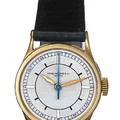43,700 HKD
Unsigned, Japanese, circa 1850. Fine and rare shitan wood, single-hand inro watch, accompanied by an ivory netsuke. Rectangular, plain, winding aperture in the back, brass bezel. Brass, outer ring divided into 100 segments, the inner into 12, twelve movable silver hour plates numbered in Japanese characters from the top: 9, 8, 7, 6, 5, 4, 9, 8, 7, 6, 5, 4 which is the equivalent of the European 24 hours, set on a florally engraved back plate with balance cock set at the top. Single blued-steel hand. Rectangular, 42 x 55 mm, gilt brass full plate, four turned baluster pillars, fusee and chain, five-whel train, verge escapement, plain brass three-arm balance, plain, blued-steel balance spring, two feet pierced and engraved cock.Dim. 66 x 54 mm.The Japanese method of telling the time originated in China and was based on the natural day from dawn to dusk. The day, from sunrise to sunset,was divided into six equal segments, as was the night. The lengths of the segments differed, of course: in summer they were long, in winters, short. Hence the Japanese hour markers had to be adjustable. It remains to be explained why the dial starts with the number "9" and then goes backwards. For the Japanese, the number 9 is a mystical number. In a clock, which was an important and mysterious object in itself, it was desirable to have the mystical number present in every hour. The mystical numer was directly attributed to midnight and noon The other hours were multiplied by the number 9 and Read more…

Auctioneer:
Antiquorum
Date:
2001-06-08




















